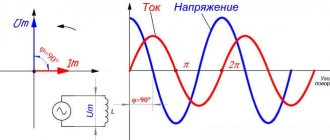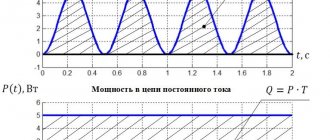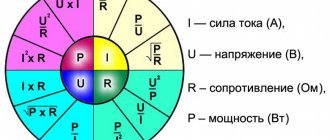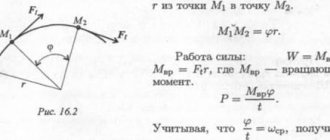Power
The battery produces power from a low start
The battery must be so powerful that the voltage does not drop under load, and the charge is enough to last until the next outlet.
Mobile device users are convinced that powerful batteries are those that last a long time on a single charge. If the battery is weak, then the device will not only have to be charged frequently, it may not even turn on, or it may first turn on and then suddenly turn off when the load increases. How does this all fit in with the container? It turns out that powerful batteries are capacious batteries. What's the difference then?
Power consumption
- The rated power
is calculated under the condition that the battery will produce the same current = 1C with the same voltage for an hour. For example: the battery for Apple iPhone 5S (C1.02.1010) has a capacity of 1690mAh and a nominal voltage of 3.8V. Let's multiply one by the other and get 6.4W. - The maximum power
is calculated based on current = 2C. For the previous example, maximum power = 12.8W. When operating at maximum power, batteries are safe, but wear out very quickly. - The maximum safe power
will correspond to a current of 3C. In our example = 19.2W. The battery may explode after 1 minute of such load.
In general, what is the greatest power a battery can produce? In laboratory conditions, we obtained peak currents of lithium batteries of several tens of Amperes. Peak loads only last a few miles/micro seconds, which is not enough to heat up and explode the battery.
Attention:
Autonomous operation
If there is no choice, the device is already in your hands, then the only thing you can do is set up an energy-saving mode or stupidly save battery power. Battery life isn't just about the time between charges - it's about precious life cycles. When the battery life runs out, you will go for a new battery. or a new phone.
Fast charge
Sudden outages
FAQ:
High power batteries - myth or reality?
- Yes, reality, but within reasonable limits.
- It is not possible to significantly increase the capacity without increasing the size.
Are CRAFTMANN batteries more powerful than the original ones?
- Unfortunately, not all. It is too presumptuous to make such a statement.
- Only LingLife series batteries are more powerful than the original ones and are completely interchangeable.
- The +2 Energy series batteries have double the capacity, but also double the thickness.
Is it dangerous to use more powerful batteries?
- No, it's not dangerous. Powerful batteries will simply last longer.
- The actual current consumed is determined by the mobile device. Familiarize yourself with and always follow battery safety guidelines
- Familiarize yourself with and always follow battery safety guidelines.
Installed capacity of the power plant
Due to the insufficient reliability and severe deterioration of electrical networks in remote villages, dacha communities and other populated areas, accidents often occur on the lines, resulting in power outages. But this causes a lot of inconvenience: refrigerators defrost, heaters and air conditioners do not work. You can protect yourself from such troubles with the help of autonomous sources of electricity, powered by a gasoline or diesel engine and called power plants (generators).
When purchasing a power plant, consumers have to take into account many parameters, such as the rated, maximum or installed power of the power plant, non-stop operation interval, voltage, number of phases and much more.
Power plants capacity
The capacity of a power plant is the rate at which electricity is transmitted or converted.
In principle, in order to select a power plant for domestic use, it is not at all necessary to delve deeply into the physical meaning of this concept. It is enough to know a few nuances related to its units of measurement and calculations of the required value. So, both the rated and maximum and installed power of a power plant are measured in kilowatts or kilovolt-amperes. These values differ only for three-phase units (by a factor = 0.8). For single-phase devices, the values expressed in kW coincide with those measured in kVA.
Rated and maximum power
Rated power is the value indicating the power of a power plant during normal operation.
The maximum power of a power plant is the value at maximum load. In this mode, the power plant can be operated only for a very limited period of time.
The concept that consumers rarely encounter is the installed capacity of a power plant. They talk about it only if it is planned to use several units to provide electricity. The sum of their rated capacities will be the installed capacity of the power plant.
The use of two or three electric generators can be economically justified in several cases. For example, you already have several units, but they are not enough to provide electricity to all the necessary equipment (household appliances, electric or garden tools, welding machine). In this case, some devices are connected to one generator, and some to another.
Another case when several nodes can carry out parallel network backup is to provide electricity to responsible consumers. In this case, two generators can be used: the main and backup.
Having understood these three concepts, you can begin to calculate the power of the power plant that you will need. To do this, you need to sum up the power of all electrical appliances that you are going to use at the same time: light bulbs, refrigerator, electric stove, TV, etc. The resulting value will approximately indicate the rated power of the power plant that will suit you.
Rated maximum production capacity.
Rated power is the technically achievable power, which corresponds to the installed power guaranteed by the supplier of the process equipment. And the maximum power is that which can be achieved through more intensive operation of the equipment (overtime or two-shift work). At the same time, achieving maximum power leads to exceeding the normal level of production costs. [p.187] Due to different methods for determining individual components of the increase in production capacity M, calculations for existing facilities should be made separately due to the following factors 1) promising organizational and technical measures M0. , including a) increasing the effective fund of time Mt, b) increasing the productivity of equipment M both due to one-time events UUe and due to uniformly acting factors yVP, c) installing new or replacing equipment Mn 2) changing the assortment of M ace 3) changes in the nominal time fund M t [p.163]
When conducting analysis in all areas, attention should be paid to the comparability of the analyzed indicators. Thus, if during the reporting period the product range (or nominal time fund) has changed compared to that adopted as the basis for calculating the input production capacity, an adjustment must be made to the value of the production capacity and the influence of these factors must be identified. [p.175]
The nominal value of the production capacity utilization factor is equal to one (Kc pm = 1). [p.192]
When calculating production capacity, a distinction is made between calendar, nominal and effective time funds (see Chapter 2). [p.102]
Discretionary policy with full indexation of wages. If workers and firms fully index nominal wages to unexpected changes in the price level, then the aggregate supply schedule will be a vertical line, as noted in Chapter 22. This means that even if the Fed is discretionary, it has no intention of increasing the money supply . The reason is that by doing so, the Fed will not be able to cause real output to rise above its natural level y0 to the level at full capacity (y). Consequently, the equilibrium state of the economy will continue to correspond to point A and there will be no inflationary trend. [p.728]
In conditions of inflation, the growth of nominal monetary values of production and sales does not provide complete information about the actual state of affairs. Additional analysis is necessary: a) comparison of the volume index with the inflation index b) comparison of output with production capacity c) correlation of production volume and working capital reserves d) assessment of the ratio of the volumes of gross, marketable and sold products. [p.310]
Production capacity is calculated based on the maximum possible operating time of the equipment and the use of space. Time fund indicators are important when calculating production capacity. There are calendar, routine (nominal) and effective (real, or working) funds of time. [p.51]
New gasification facilities reach nominal gas consumption within a certain period of time, i.e. develop over time. This period is the period of development of m. It is followed by a period of stable or gradually increasing gas consumption r 2. In accordance with this, to ensure the efficiency of the system, its production capacity is introduced in stages. In this way, the characteristics of the gas supply system are adjusted to the characteristics of consumers and ensure the fullest use of production capacities. [p.55]
When determining various indicators of extensive equipment utilization, as well as the production capacity of an association, enterprise, or workshop, the operating time fund of the equipment is taken as the initial data. It is customary to distinguish between the following equipment operating time funds: calendar, routine (nominal), planned (effective) and actual, which are determined per unit or group of installed equipment. [p.87]
Example. The average annual capacity of the urea workshop, calculated based on the hourly unit capacity of the leading equipment, the annual nominal capacity of its operation and the number of operating devices, is 250 thousand tons. With the planned use of production capacity equal to 97%, the planned production output will be 242.5 thousand. t. In the case of carrying out organizational and technical measures, the planned production output should be increased to 256 thousand rubles. The actual production output for the year amounted to 247.5 thousand rubles, and the actual use of production capacity was 96.7% (247.5 256.0 100). Consequently, capacity utilization in the reporting period did not improve, but worsened. [p.237]
To assess the use of production capacity of workshops and plastic processing plants, it became necessary to calculate the nominal (based on the loading of the equipment with the optimal range of products) and reduced (based on the loading of the equipment with the actual range of products) capacity. The degree of rational loading of equipment for plastics processing can be expressed by the ratio of the reduced power to the nominal, the so-called reduction coefficient Kp. With the help of this coefficient, it becomes possible to reduce the nominal power of the equipment fleet to the actual one. [p.52]
Let's consider the ratio of the reduced (actual) production capacity for plastic processing to the nominal (reduction coefficient) as of 1/1 1971 [p.52]
The assessment of the use of structures is made on the basis of the production characteristics of the facilities, usually given in their throughput or capacity (water towers, inter-shop roads, reservoirs and cisterns, bunkers, etc.). An indicator of the production capacity of, for example, an in-plant transport road is its throughput per unit of time or the number of goods transported along each kilometer. A comparison of actual and design data for the first indicator characterizes the use of the road in terms of frequency (density) of traffic, and for the second - the use of the road in terms of freight turnover. Comparison of the nominal volume of a reservoir (tank) and its average (per day, per month, per year) filling makes it possible to judge the use of this object. [p.238]
Conditions for comparability of options for production results when repairing power equipment. The product of energy repair production is the ensured readiness of equipment for productive use (bearing the load) while maintaining a normal level of production capacity and the necessary performance qualities. It is measured in units of operational readiness time, as well as in units of service life, i.e., the possible output of repaired equipment when used over time ta.T - with a rated load. [p.68]
Eliminating the influence of factor 4 of structural shift on the overall change in the level of equipment utilization and the amount of production capacity under the influence of all factors Calculation of the impact on level L5. equipment load and the power factor of the change in the nominal operating time of the site equipment [p.121]
To calculate the amount of production capacity, as well as the load of equipment and space, assembly and welding devices and workplaces, it is necessary to determine the annual fund of their operating time. There are calendar, nominal and real funds of time. [p.188]
EXCESS CAPACITY - machines and equipment available to the enterprise, in excess of those purchased for operation under nominal, design conditions. Excess production capacity is intended for emergency situations when there is a need to urgently expand production or replace failed equipment. The optimal load of production capacity is considered to be 80%; this load corresponds to 20% I.M. [p.245]
In general, the asymmetry of the Phillips curve can be explained by several hypotheses that vary the nature of the nonlinearity with the capacity constraint model, the signal extraction model, the adjustment cost model, the downward nominal wage rigidity model, and the monopolistic competition model. [p.168]
EXCESS CAPACITY - a set of automated and computerized equipment (machines and equipment) available to the enterprise in excess of those purchased for operation under nominal design conditions. Excess production capacity, which is a positive result of the enterprise’s operation, is intended for emergency situations (if there is a need to urgently expand production, replace broken equipment or repair a machine). When the enterprise is loaded with production capacity at 80%, there is 20% excess capacity. This workload is optimal for the enterprise. [p.239]
The production capacity of the workshop for the production of nominal products is presented by the data in Table. 88. [p.300]
During 2005, OAO Gazprom successfully placed several bond issues. Thus, on February 3, ruble bonds of series A3 were placed in the amount of 10 billion rubles, with a nominal value of 1,000 rubles, with a circulation period of 3 years. The bonds provide a coupon of 4% of the nominal value with payment every 180 days. The placement price based on the results of the auction on the MICEX was determined at 100.69% of the nominal value, which corresponds to an effective yield to maturity of 8% per annum. Investors submitted applications in the amount of 15.88 billion rubles. Further, in the summer of 2005 (August 11), OJSC Gazprom placed ruble bonds of series A6 in the amount of 5 billion rubles, with a par value of 1000 rubles, with a circulation period of 4 years. The coupon rate, paid every 182 days, based on the results of a competition on the MICEX stock exchange, was determined at 6.95% per annum. Investors submitted 158 applications worth more than 12 billion rubles. During the auction, 45 applications were satisfied. The securities were placed with a record low yield compared to corporate bond issues placed for similar periods. Finally, on October 12, OAO Gazprom placed ruble bonds of series A5 in the amount of 5 billion rubles, with a par value of 1,000 rubles, with a circulation period of 3 years. The coupon rate, paid every 182 days, based on the results of a competition on the Moscow Interbank Currency Exchange, was determined at 7.58% per annum. Investors submitted 120 applications for an amount exceeding 9 billion rubles. During the auction, 73 applications were satisfied. The funds raised as part of the placement were planned to be used to finance capital investments necessary to maintain current production capacities, implement new promising projects, as well as refinance short-term debt and optimize the structure of the debt portfolio. [p.174]
World oil prices in 2005 were at extremely high levels, exceeding $50 per barrel. In the second half of 2005, oil prices reached a historical maximum in nominal terms. The price of Brent oil in 2005 was 87.5% higher than the average level of the previous five years. The main reasons for this situation were the high growth rates of the world economy, in particular the economies of the USA and China, and the low level of free production capacity for oil production, which did not allow a rapid increase in production to meet the growing demand for oil. OPEC has actually abandoned maintaining world oil prices within the target price range of 22-28 dollars per barrel previously established by this organization. and pursued a policy of moderately increasing oil production within the limits of available production capacity. At the March (2005) OPEC conference, it was announced that oil production by member countries of the organization would increase by 500 thousand barrels. per day, and from July 1, 2005, the total production quota of OPEC member countries was increased by another 500 thousand barrels. per day, up to 28.0 million barrels. per day. These measures, however, did not have any visible impact on the dynamics of oil prices. At the September (2005) OPEC conference, member countries of the organization announced their intention to use free oil production capacity of 2 million barrels. per day, if necessary, for three months, starting October 1, 2005. In practice, however, only Saudi Arabia had sufficiently significant free production capacity, and limited demand for heavy sour oil limited the increase in oil production to a certain extent OPEC countries. [p.211]
PRODUCTION CAPACITY - the maximum possible volume of product output for a certain period (usually a year, month) with full use of equipment and production space at a given enterprise. Excess capacity - machines and equipment available at the enterprise, in excess of those that were purchased to operate under nominal, design conditions. Excess production capacity is intended for emergency situations when there is a need to urgently expand production or replace failed equipment. The optimal load of production capacity is considered to be 80%; this load corresponds to 20% of excess capacity. [p.135]
The nominal production capacity of Oil Refinery JSC for oil refining is 3.8 million tons of oil per year. Its closest (geographically) competitor in the Western Ukrainian market is capable of processing up to 3.2 million tons of oil per year. However, the proximity to JSC Refinery of an enterprise related by the nature of its production activities does not create any difficulties for it in its competitive position. Firstly, JSC Refinery has its own special geography of the petroleum products sales market. Secondly, JSC Refinery has historically developed a certain circle of regular consumers who ensure stable demand for the main petroleum products it produces. [p.98]
When electricity for production needs is obtained from outside, its cost is paid at a two-rate tariff. The first tariff rate provides for annual payment by the enterprise of the nominal total power of connected transformers or electric motors with a power of up to 50 kW or more or a maximum load of at least 1000 kW, regardless of the amount of electricity consumed; the second rate is payment for the actual amount of electricity consumed. [p.189]
Thus, drilling rigs, as is known, do not have a set rated power. They are classified by load capacity, although this indicator does not reflect their main industrial purpose. It is difficult to calculate the average annual capacity of drilling rigs, since their manufacturer is [p.183]
Enterprises operate a) on various raw materials, direct distillation plants - on various types of oil (for example, a group of Baku oil refineries processes several dozen types of oil), secondary process plants - on various fractions of the first and second stages of production b) at various varying capacities (as several exceeding nominal, and never reaching it, which in turn depends not only on the technical and economic characteristics of the installations and the planning and production situation at the time of implementation of the adopted planning decisions, but also on the quality of the processed raw materials) c) in various technological modes of the direct distillation installation - for the production of winter and summer diesel fuel, catalytic reforming units - for soft and hard [p.6]
The main items of production costs for the period (quarter) at rated production capacity include [p.230]
Standardization of the rated voltage of 660 V determined the direction of development of electrical engineering along the line of increasing unit power, primarily asynchronous motors, first for coal mines, then in the mining, chemical and metallurgical industries. The standardization of this promising leading voltage value has directed the efforts of all scientific and industrial enterprises towards solving specific problems in creating powerful electric motors, transformers, electrical apparatus and other electrical devices for a voltage of 660 V. [p.243]
The continuity of production processes determines, when using regulatory methods, the need to standardize and account for individual manufactured products (intermediate products) of the amount of material resources that are constantly in technological systems. The natural limit of such a quantity of raw materials functioning in technological systems as a permanent reserve is the nominal dimensions of the capacity of technological tanks, apparatus, units and pipelines. Loaded reagents that have entered and have not reacted, intermediate and by-products introduced and removed from technological systems , but not accepted by the technical control department, represent, like the remains of semi-finished products of our own production, permanent backlogs of work in progress, the size of which is usually maintained at the same level. However, with standard methods, if the equipment is not loaded at full capacity (which leads [p.16]
When assessing the production result of the work of repair personnel based on the service life of the repaired equipment, i.e. in units of potentially possible output of the repaired Prem unit when used with rated power N during the entire period of operational readiness /e.g, specific costs per unit are obtained service life, rub/(kWh), t steam, t dust, etc. [p.321]
The SSA model, like the NSA, usually uses the nominal dollar as a unit of measurement, without adjusting for changes in its purchasing power. The procedures for registering business transactions are the same as in the NSA. The differences are related to the concept of capital maintenance used within the framework of the SSA, which is focused on maintaining production capacity or efficiency. This is reflected in the implementation of periodic adjustments for changes in replacement prices for inventories and fixed assets. The cost of production is calculated on the basis of the initial inventory values, adjusted for changes in the current price (replacement price) by the end of the period. In this model, the gain from holding assets is interpreted not as profit, but as a necessary direct addition to equity capital. Similarly, fixed assets are revalued in each period at their current price (replacement price). Depreciation is calculated on the basis of current value, and the increase in replacement cost from period to period is treated as a direct addition to equity. Opinions vary as to whether this model should recognize gains or losses from holding monetary assets or from holding financial liabilities during periods of changes in the purchasing power of the dollar. [p.341]
The production load of an enterprise is the volume of production determined in accordance with a calendar plan based on consumer orders and product sales forecasts. It is usually set in the form of the time required to produce the required quantity of products, the utilization rate of production capacity, a percentage of normal production output, a percentage of the nominal operating time of the equipment. [p.403]
The average nominal force of one hydraulic press at factories ranged from 90.1 (at the Komsomolskaya Pravda plant) to 212 tf (at the Sverdlovsk plant), i.e. almost 2.4 times. For injection molding machines, the average maximum casting volume was 120.5 tons at the plant named after. Komsomolskaya Pravda to 445 cm3 at the Kemerovo Karbolit plant, i.e., it differed by no more than 3.7 times. At the same time, in many factories where large equipment is installed, the size of production capacity per unit area turned out to be less than in factories with small machines. For example, at the Sverdlovsk plant the average nominal force of one hydraulic press was 212 tf, the reduced power per 1 m2 was 0.3 t/year, and at the plant named after. Komsomolskaya Pravda - 90.1 tons and 1.13 tons/year, respectively, or 3.8 times more. Similar examples can be given for injection molding machines. Thus, at the Orekhovo-Zuevsky plant Karbolit, the weighted average maximum volume of casting one thermoplastic machine was 334.7 cm3, and the reduced capacity per 1 m2 of production area of the injection molding shop was 0.21 t/m2, and at the plant named after. Komsomolskaya Pravda and at the Uzlovsky plastics plant - 120.5 cm3 and 1.37 t/m2 and 174.6 cm3 and 0.97 t/m2, respectively. [p.56]
Thus, drilling rigs do not have a set rated power. They are classified by load capacity, although this indicator does not reflect their main industrial purpose. It is difficult to calculate the average annual capacity of drilling rigs, since their productivity is determined by complex, primarily natural, factors (drilling depth, strength and drillability of rocks, etc.). Therefore, with some degree of assumption, the degree of intensity of use of drilling rigs can be assessed by the ratio of the actual volume of penetration to the maximum possible achieved in similar wells [p.164]
CALCULATION OF COSTS FOR PAYMENT OF ELECTRICITY Installed capacity of production equipment - 100 kW Installed capacity utilization factor - 0.5 Tariff for electricity supply - 0.03 USD per 1 kW-hour Based on these data, monthly costs for payment of electricity at the rated capacity of production will be - 1080 USD (0.03 USD xl00 kW x 12 hours x 30 days). [p.233]
The installed electrical capacity of a production/energy association, equal to the sum of the rated capacities of the generators installed at power plants, is often greater than the available capacity of the energy association, since part of the installed capacity cannot be used (with high water pressures at hydroelectric power stations and thermal loads of turbines with back pressure in the presence of restrictions in the throughput of steam pipelines, power lines, heating networks with insufficient fuel supply capacity, steam boilers, hot water boilers in the presence of design defects in the main and auxiliary equipment, etc.). [p.114]
What is the difference between rated power and maximum
Optimal Engineering Solutions in the Electric Power Industry
Stay up to date with news
Main themes
- Technological connection
Definitions of the concept “Power” in the electric power industry
Definitions of the concept “Power” in the electric power industry
Transformer power is the total power of transformers of power receiving devices of an electrical energy consumer, calculated in megavolt-amperes (MVA)
Declared power - the maximum amount of power consumed during the current regulation period, determined by an agreement between the network organization and the consumer of electric energy transmission services, calculated in megawatts (10 6 Watts)
Connected power - the total value of the rated power of transformers and power receiving devices connected to the electrical network (including indirectly) of the electrical energy consumer, calculated in megavolt-amperes (MVA)
Power of an electrical installation (group of electrical installations) - The total active power supplied at a given time by a generating electrical installation (group of electrical installations) to receivers of electrical energy, including losses in electrical networks [GOST 19431-84]
Installed power of an electrical installation - The highest active electrical power with which an electrical installation can operate for a long time without overload in accordance with the technical specifications or equipment passport [GOST 19431-84]
Connected power of an electrical installation - The sum of the rated powers of transformers and consumer electrical energy receivers directly connected to the electrical network [GOST 19431-84]
Instantaneous power is the product of the instantaneous voltage applied to a circuit and the instantaneous value of the current in this circuit.
Differences
Active power is measured in kilowatts, and total or nominal power is measured in kilovolt amperes. Volt ampere with kilovolt ampere, being a power unit of current, is calculated as the product of current ampere values in an electrical circuit and the volt voltage at its ends. A watt per kilowatt is the energy accomplished per second and is equal to one joule. The measurement is carried out using the force of constant energy at a volt voltage.
You might be interested in Features of Fuquay eddy currents
Note! Only a part of the device’s power is involved at the time of work activity. The rest comes out.
How do the values differ?
What is the difference between RMS and peak power in an audio system?
In the world of consumer electronics, you'll often hear about watts, power consumption, and power output. The terms are used interchangeably to refer to two values, i.e. root mean square (RMS) and rated peak (maximum) power. Power rating is one of the most important factors in creating the ideal sound system. So it's important to know what these two numbers refer to, whether you're looking for speakers, amplifiers, or subwoofers.
When choosing a high-performance entertainment system, most people choose to buy audio and sound equipment based on power. However, this approach can lead to some difficulties for hobbyists who do not understand the difference between RMS and peak power. In addition, some may ignore the ratings and choose based on the celebrity of the brand, which will somehow affect the final result.
So if you're going to spend your hard-earned money on surround speakers, a subwoofer, or even an amplifier, you'll need some basic information about the power rating. The comprehensive guide below will help you understand these two values, which will help you build a decent sound system.
RMS power
RMS or simply RMS in watts refers to the continuous power delivered to a speaker or subwoofer, or how much continuous power an amplifier can output. RMS values are usually lower than peak values, but they represent what will actually be reproduced by the audio system. Think of RMS power as the average power that a music speaker can handle on a daily basis without compromising sound quality or causing any distortion.
Peak power
Peak power is the maximum power level that a speaker or subwoofer can handle in a short burst without blowing through. The same applies to amplifiers as the absolute amount of power they can deliver before failing or distorting.
We can compare the peak watts to the maximum speed on your car's speedometer. For example, you can drive at a speed of 180 km/h, but you will not be able to maintain this speed for long without causing mechanical or thermal damage to the car. Likewise, peak power levels can only be sustained for a fraction of a second, although there is no clear definition for how long.
If the device is running at a constant peak power, the wires can overheat, which can quickly damage your music speakers.
RMS Power vs. Peak Power!
As you take a quick look at various products, you'll notice that some manufacturers rate the power capabilities of their products using either peak watts or RMS wattage, while most use both. For example, one product may be rated at 150 watts, while another brand may be rated at 75 watts.
At first glance, you might think that the first option is better because it is designed for a higher power level than the second. However, upon closer inspection, you may notice that the first product is rated for peak power, while the second advertises RMS power. Generally, the peak power consumption of a device is twice the average RMS power, which basically means that the above products are effectively the same power: 150W peak/75W RMS.
However, most audio equipment manufacturers choose to place more emphasis on maximum peak power, so that to the user the products appear as if they can "output" much more than they actually can. While this may sound convincing, running your audio equipment at peak power not only pisses off your neighbors, it also damages your audio system, requiring you to replace some parts or buy a new unit altogether. Thus, if you want your music speaker to last for many years, then it is worth paying attention to the RMS power, the power consumption, and the one with which you want to enjoy music.
However, when it comes to these technical details, don't be confused by speaker power ratings and amplifier specifications. Amplifiers generate power in an audio system, which is not the case with speakers and subwoofers. Therefore, speaker power ratings refer to the amount of power your speakers can handle from an amplifier. On the other hand, amplifier performance refers to how much power it can deliver for maximum audio performance.
Let's summarize
RMS and peak power play an important role in your audio system, and they are vital when comparing your speakers to amplifiers or subwoofers. When matching speakers or subwoofers to amplifiers, you should compare either their RMS values or their peak values.
Maximum and rated generator power
When choosing a Yanmar diesel generator model, you need to focus on its capabilities, which must meet the needs of the facility being serviced. If the unit is purchased for the home, then it is necessary to add up the power of all electrical appliances in use (from a laptop and lighting to household tools). The result obtained should not exceed the active power of the diesel generator set specified in the operating manual.
What do rated and maximum power mean?
The technical documentation for Yanmar products indicates two types of diesel generator power:
- full (maximum);
- active (nominal) in kW.
Within the limits of active power, the generator can operate indefinitely until its fuel runs out.
For example, the YEG170DTLS model has a rated power of 10.1 kW and a maximum of 11.1 kW. Up to 10.1 kW the station will operate in permanent mode, and in the range from 10.1 to 11.1 kW - in temporary mode.
Power reserve - why is it needed?
When purchasing a non-domestic autonomous power plant, it is also important to take into account the operating conditions (climate, temperature). If these parameters change from those declared by the manufacturer, the performance of the power plant may decrease. Therefore, if you plan to use the unit outdoors, you need to provide a power reserve at the stage of purchasing a diesel generator set.
A power reserve is also necessary when connecting devices with electric motors, which include refrigerators, electric mowers, and pumps. The reason for this is that starting the engine requires power that is 3-3.5 times higher than the rated power. If this is not provided for, then a landslide drop in voltage cannot be avoided.
In this case, the calculation must be done in the following order:
- We take the rated power of the most productive electrical appliance and multiply it by three.
- If other devices with electric motors do not turn on at the same time as the first one, then we add their nominal parameters to this value.
- We also add the power of all other active energy consumers that will be turned on simultaneously with the first device.
- We increase the obtained result by 20-30% and obtain the generator power for the home with an optimal reserve, which will suit your needs and ensure the operation of electrical consumers in the absence of network electricity.
The total power of connected appliances must not exceed the rated power of the Yanmar generator. The Japanese manufacturer offers diesel generator sets from 2.0 to 3530.0 kW, so on our website it will not be difficult to choose an autonomous diesel power plant for home or production.
Nominal and actual power
Nominal and actual power
What is the difference between kVA and kW?
Volt-ampere (VA or VA) is a unit used to indicate the apparent power of alternating current, defined as the product of the current in a circuit (measured in amperes, abbreviated A) and the voltage at the circuit terminals (measured in volts, abbreviated B).
Watt (W or W) is a unit used to measure power. This unit owes its name to the Scots-Irish inventor James Watt. 1 watt is the power at which for a time equal to 1 s. 1J of work is done. A watt is a unit of active power, which means that 1 watt is the power of a direct electric current of 1A at a voltage of 1B.
!When choosing a diesel generator, you need to remember that the total power consumed by the device is measured in kVA, and the active power expended to perform useful work is measured in kW. Apparent power is calculated as the sum of the two terms reactive power and active power. Quite often, the ratio of total and active power has different values for different consumers, therefore, in order to find the total power of all consuming equipment, it is necessary to sum up the total, rather than active, power of the equipment.
The power of most industrial electrical appliances is determined in watts; this is the active power released by a resistive load (light bulb, heating devices, refrigerator, etc.).
Typically, power consumption refers to the active power that goes entirely to useful work. If we are talking about an active consumer (kettle, incandescent lamp), then, as a rule, the rated voltage and rated power in W are written on it; this information is enough to calculate the cosine “phi”.
Angle "phi" is the angle between voltage and current. For active consumers, the angle “phi” is equal to 0, and, as is known, cos(0) = 1. In order to calculate the active power (denoted by P), you need to find the product of three factors: current through the consumer, voltage at the consumer, cosine “phi” ", that is, carry out calculations using the formula
Let's consider an example for a heating element. Since this is an active consumer, cos(0) = 1. The total power (denoted by S) will be equal to 10 kVA. Therefore, P=10× cos(0)=10 kW - active power.
If we are talking about consumers that have not only active, but also reactance, then, as a rule, they are indicated by P in W (active power) and the value of the cosine “phi”.
Let's give an example for an engine whose label says: P=5 kW, cos(φ)=0.8, it follows that this engine, operating in nominal mode, will consume S = P/cos(φ)=5/0.8= 6.25 kVA - total (active) power and Q = (U×I)/sin(φ) - reactive power.
To find the rated current of the motor, it is necessary to divide its total power S by the operating voltage equal to 220 V.
However, the current rating can also be read on the label.
To see the difference between kVA and kW in practice, explore the products in the Diesel Generators section >>
Why is the power on generators indicated in VA?
The answer is as follows: let the power of the voltage stabilizer indicated on the tag be 10,000 VA, if a certain number of heating elements are connected to this transformer, then the power supplied by the transformer (the transformer operates in nominal mode) will not exceed 10,000 W.
In this example, everything fits. However, if you connect an inductor (many coils) or an electric motor with a value of cos(φ) = 0.8 to the voltage stabilizer. As a result, the power delivered by the stabilizer will be equal to 8000 W. If for an electric motor сos(ф) = 0.85, then the output power will be equal to 8500 W. It follows that the inscription 10000VA on the transformer tag will not correspond to reality. That is why the power of generators (stabilizers and voltage transformers) is determined in full power (for the considered example, 1000 kVA).
What is kW
The unit of active electrical force that is a multiple of 1000 watts is called the kilowatt. Kilowatts reflect the performance of power plants, power lines, transformers and large networks, when the figure in watts would be too large and inconvenient for calculations.
The unit kW should be distinguished from kWh. Kilowatt-hours measure the amount of electricity supplied or generated in a given time. Kilowatts show the total energy consumption, and kilowatt hours show the performance of the device.










